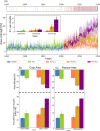Increased future occurrences of the exceptional 2018-2019 Central European drought under global warming
- PMID: 32764540
- PMCID: PMC7413549
- DOI: 10.1038/s41598-020-68872-9
Increased future occurrences of the exceptional 2018-2019 Central European drought under global warming
Abstract
Since the spring 2018, a large part of Europe has been in the midst of a record-setting drought. Using long-term observations, we demonstrate that the occurrence of the 2018-2019 (consecutive) summer drought is unprecedented in the last 250 years, and its combined impact on the growing season vegetation activities is stronger compared to the 2003 European drought. Using a suite of climate model simulation outputs, we underpin the role of anthropogenic warming on exacerbating the future risk of such a consecutive drought event. Under the highest Representative Concentration Pathway, (RCP 8.5), we notice a seven-fold increase in the occurrence of the consecutive droughts, with additional 40 ([Formula: see text]) million ha of cultivated areas being affected by such droughts, during the second half of the twenty-first century. The occurrence is significantly reduced under low and medium scenarios (RCP 2.6 and RCP 4.5), suggesting that an effective mitigation strategy could aid in reducing the risk of future consecutive droughts.
Conflict of interest statement
The authors declare no competing interests.
Figures



References
-
- Pall P, et al. Anthropogenic greenhouse gas contribution to flood risk in England and Wales in autumn 2000. Nature. 2011;470:382–385. - PubMed
-
- Min S-K, Zhang X, Zwiers FW, Hegerl GC. Human contribution to more-intense precipitation extremes. Nature. 2011;470:378–381. - PubMed
-
- Ciais P, et al. Europe-wide reduction in primary productivity caused by the heat and drought in 2003. Nature. 2005;437:529–533. - PubMed
-
- Liu, X., He, B., Guo, L., Huang, L. & Chen, D. Similarities and differences in the mechanisms causing the European summer heatwaves in 2003, 2010, and 2018. Earth’s Futurein press (2020).
-
- Ionita M, et al. The European 2015 drought from a climatological perspective. Hydrol. Earth Syst. Sci. 2017;21:1397–1419.
Publication types
LinkOut - more resources
Full Text Sources

